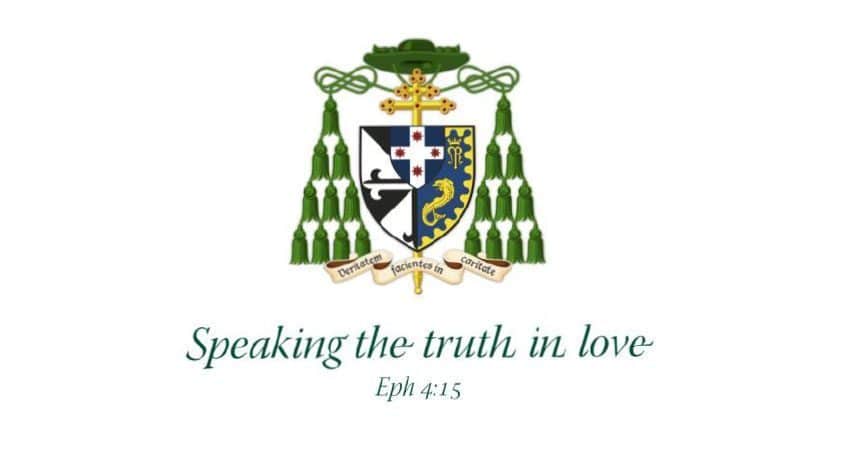Homily for Mass for the Solemnity of the Ascension of the Lord, Year B

Introduction to Mass for the Solemnity of the Ascension of the Lord, Year B
St Mary’s Cathedral, Sydney, 17 May 2015
As our holiest season of Easter draws inexorably to its close, we celebrate this week two wonderful feasts, those of the Ascension of the Lord into heaven and the descent of the Holy Spirit from heaven at Pentecost. Today I welcome back the neophytes who joined us during Lent for scrutiny and to declare their intention to be baptized and enter the life of Christ and His Church at Easter. Now, in their period of mystagogia or post-baptismal catechesis and deepening, they join us once more, proud to call themselves Christians and Catholics. I welcome them, along with pastors Msgr John Usher, Fr Fred Kado and Fr Paul Smithers, their sponsors and families, their fellow parishioners including RCIA team members and say to you all: welcome to the Catholic Church; you are always most welcome.
Homily for Mass for the Solemnity of the Ascension of the Lord, Year B
St Mary’s Cathedral, Sydney, 17 May 2015
Those of you especially au fait with pop culture will know the 1967 Rolling Stones song, 2000 Light Years From Home. It was written by Mick Jagger while in Brixton prison for drug offences and featured in rock tours and albums of the Rolling Stones, and in the film Men in Black 3. Though some people like the song, I must confess that I have absolutely no idea what it was about: maybe you have to be high on drugs and rock’n’roll to get it! Perhaps its imprisoned author was just lonely, feeling a long way from home; or perhaps he had been influenced by the common vision of Jesus on Ascension Day, lifting off like a space ship and now, two millennia later, being 2,000 light years from home.
Well, whatever is going on in that song, I wouldn’t recommend Mr Jagger as your spiritual adviser. Jesus is not superman or an astronaut flying through the air. So what is going on in our readings today and in our Creed when we say Jesus ‘ascended’ or was ‘lifted up’ into heaven (Acts 1:1-11; Eph 1:17-23; Mk 16:15-20)? One simple answer is that He has returned to the place from which He previously descended, to heaven; instead of being 2,000 light years from home, He’s actually home now; it’s us who are a long way from home, at least from His home. And there is something to be said for that: there is a sense in which we are all wayfarers on this earth; that our hearts are restless; we will only be truly ‘at home’ when we are with God and His saints in heaven.
The risk with such talk, however, is that it seems to suggest that earth was never truly Jesus’ home, that earthlings were never truly His people, that He looked human but underneath He was an alien. Orthodox Catholicism will have none of that: though humanity was created for intimacy with God, we wandered far away from Him. By selfishness and sin we obscured the image of God in us, the intelligence and freedom, the ability to love and do good, that make us God-like. Yet God as far as we wandered, God kept close by, as it were; He kept drawing us back to Himself, through nature and reason, through faith and revelation, through Law and Prophets. In the end, having more or less tried every other remedy, He gave His only Son. But not as a mere tourist, not as an alien, not as a demigod or superman: no, God united Himself to humanity in an extraordinary, almost unthinkable way: He took our nature in Jesus Christ. Jesus was the truth and love, the justice and mercy of God for us, but He communicated and demonstrated those very graces in action as one of us. In Him the union of God and humanity was restored and perfected. From the Annunciation to the Ascension – almost all the mysteries of the Holy Rosary we pray especially in May – Jesus’ mission amongst us would be conducted as one of us.
But now He’s ‘ascended’? What sense are we to make of this, if he was no superman or astronaut? Well, whatever it means for the Christ to ascend, it cannot mean He is travelling through space and time like the Rolling Stones spaceship: for in these Easter weeks in which we have glimpsed Him as the Risen Lord, it has been all too clear He is no longer constrained by distance and chronology. Ascension must refer to Him somehow transcending time and space as we know them, entering definitively into the realm of eternal life with God.
Which is all very well for Jesus, you might say, but where does that leave us? Alone and desolate, like Mick Jagger in prison? Certainly not. Now Christ can be present to us as He could never be before. My diary secretaries wish I could be in several places at once, but as a bodily being when I’m in our beautiful cathedral I’m nowhere else. Telephones, photos and Facebook can carry our image or voice to several places at once; our minds can be distracted, so that we think of somewhere else; but we are not truly in the places of our images or imaginings. Yet that very possibility, of being present to ‘the many’, is what the Ascension opened up to Our Lord. Especially through the Eucharist, He can now be present to us with a universality and intimacy He could not be before.
And so the Ascension should magnify our desire to worship. Some congregations seem to look at themselves or at each other, rather than God; to pray to themselves or each other, not God; to draw inspiration from themselves and each other, not God. That may bring the comfort of fellow-travellers but it is not worship. True worship allows us to transcend ourselves. The Ascension says loud and clear: however gifted and limited you are, however beautiful and finite is creation, there is more than all this. The Ascension invites us to look upwards, look beyond the field of our ordinary sight, to the very the persons and life of God. It summons us into the life of the Holy Trinity, with Christ our forerunner at the centre and angels and saints surrounding Him like a halo. We strain, with our eyes and necks and whole being to see beyond the here and now, and to glimpse, even now, the life to come. We try to blend our voices with the heavenly host, anticipating the life beyond.
A last thing today’s Feast should signal to us: the Ascension means that Someone with our lowly human nature has now been raised to the heights. Today Heaven and Earth meet and a human being is seated at the right hand of the Father in majesty. One of us is now transfigured and not just temporarily on a mountain, but for all eternity and in heaven. That’s a wonderful thing in itself, but it is also a premonition of our own glory as the adopted children of God. Christ’s fulfilment is our destiny also; His trajectory our roadmap. We too should aspire to heavenly glory: for the One who now sits beside the Father Almighty bids us follow, like a train behind a king’s robes, the tail on a comet.
But can mere mortals really follow where Jesus, true man but also true God, has gone? It’s natural for Him to float to the skies, since He is lightness and divinity; it’s natural for Him to ascend to heaven because heaven is, precisely, being with Him. This is, I think, is why we have the last two mysteries of our May Rosary: the Assumption and Coronation of Our Lady. Our Mother Mary, we know, has also been assumed into heaven. She has entered into the life of her Risen and Ascended Son. She demonstrates that that prospect is not reserved for Him alone but also for His disciples, His adopted siblings and beloved friends, all those who join her this coming week in the cenacle praying for the gifts of the Holy Spirit of Pentecost. Mary is no god; she is only a human being. If she can join Christ in the court of heaven, so might we!

